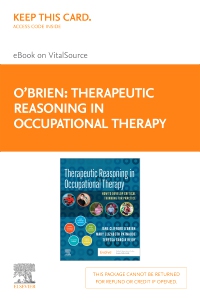
Therapeutic Reasoning in Occupational Therapy - Elsevier E-Book on VitalSource (Retail Access Card), 1st Edition
Elsevier eBook on VitalSource - Access Card

Help your students develop the clinical reasoning skills needed to be effective decision-makers in OT practice! Therapeutic Reasoning in Occupational Therapy: How to Develop Critical Thinking for Practice uses practical learning activities, worksheets, and realistic cases to help you master clinical reasoning and critical thinking concepts. Video clips on the Evolve website demonstrate therapeutic reasoning and show the diverse perspectives of U.S. and international contributors. Designed to be used as a workbook, this "how-to" text makes it easier to apply clinical reasoning in a variety of practice settings.
-
- Dynamic, interactive approach reinforces student understanding with learning activities embedded into each chapter.
- Case studies and experiential learning activities in each chapter flow from simple to complex, and represent occupational therapy across the lifespan.
- AOTA’s Occupational Therapy Practice Framework, 4th Edition and current OT practice are reflected throughout the book.
- Practical learning activities and templates are clinically relevant and designed to support reasoning in a variety of practice settings.
- Video clips on the Evolve website are contributed by practitioners, educators, and students, reinforcing content and showing how therapeutic reasoning applies to real-world cases.
- Worksheets and/or templates are included in each chapter to enhance learning and for use in practice.
- Assessments in each chapter measure therapeutic reasoning outcomes.
- Student resources on Evolve include printable PDFs of the in-text worksheets, video clips, additional case examples, templates for assignments, exemplars, and reflective activities.
- Educator resources on Evolve include an image collection and PowerPoint® slides, plus video clips associated with selected assignments.
-
- Student Success: Therapeutic Reasoning Process
- Occupation as the Foundation for Therapeutic Reasoning
- Models of Practice and Frames of Reference: Essential Concepts for Therapeutic Reasoning
- Therapeutic Use of Self
- Using Evidence to Support Therapeutic Reasoning
- Assessment: Gathering Information and Making Hypotheses
- Teamwork
- Applying Knowledge to Develop Therapeutic Reasoning
- Creative Intervention Planning
- Reflection and Assessment: Measuring Outcomes


 as described in our
as described in our 